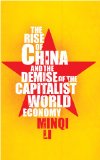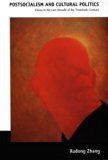The Working Class against the Harmonious Society: Struggle in the Economic Powerhouse
From Organise! #73 (winter 2009), reposted on Libcom (print copies available from AF). My only complaints are (1) they should indicate more of their sources, (2) they should read more than CLB and news reports to learn about the changing terrain of class struggle and workers’ subjectivity in China today (there are now quite a few ethnographic texts on this in English, including the work of Hairong Yan, Pun Ngai, Stephen Philion, and Ching Kwan Lee, to name a few); and (3) they don’t deal with the re-employment of most of the migrant workers laid off last year (not that that necessarily contradicts their argument, but people have used that as evidence that the recovery is real, so they should at least address it). There is a section on Sannong Zhongguo devoted to the situation of laid-off migrants, along with a set of reports to be published soon as a book edited by He Xuefeng (both in Chinese - hopefully I or someone else will get around to introducing these in English eventually). Also see this discussion on the Zhongguo list, which unfortunately died before getting very far along.
Libcom’s abstract: “The global economic crisis had a severe effect on China. However, there has been much talk recently about its impressive recovery and the return of its economy to growth. This article analyses the situation in China, and argues that the economic crisis catalysed a wave of struggle which has continued into the present, regardless of the supposed health of the economy.”
If we’re to believe the commentary to be found in the mainstream media, China is the economic powerhouse that will pull us through the global economic crisis. Though the economic slowdown which hit the country in late 2008 was widely reported, and led to claims that China’s meteoric rise was stalling, the country’s ‘recovery’ since has been the subject of many excited column inches. The growth of its economy in 2009 has been seen as part of Asia’s ‘astonishing rebound’ – or at least that of rising powers like China, India and Indonesia – by publications such as The Economist.1 The implications for world recovery and the balance of power are significant, it is argued.
Likewise you could be forgiven for thinking that the inhabitants of the worlds’ most populous country are increasingly enjoying the fruits of economic growth and the bright future that faces them. As has been well reported, automobile and electronic goods consumption in China is up, the Chinese are entering cyberspace in droves, and Western consumer outlets like Wal-Mart are springing up in Chinese cities. To the Chinese government, this is ‘socialism with Chinese characteristics’, the ‘harmonious society’ of state propaganda marching along the path of success and development. The biggest threat to this picture of successful development seems to be ethnic tension and threats of regional secession: the rioting between Uyghur Muslims and Han Chinese earlier in the year received much more media coverage in the West than ‘mass incidents’ of a similar scale but which lack the racial element often do, and the same can be said of the unrest in Tibet last year.
However, what we want to argue here is that behind this picture of growth and success lays class conflict on a huge scale. The conflict between Chinese workers and their employers – along with their friends in the ruling Communist Party – has increased in intensity as the economic crisis has hit China, and has continued to deepen and continue as workers learn important lessons from struggles. This wave of struggle has continued well into 2009, and has yet to break.
China and the world economy
Though we may be familiar with the talk of China as a rising economic superpower, the tendency of the media to discuss the matter simply in terms of competing national blocs, with China playing the role of a growing threat to US hegemony , has meant that China’s overall role in the global economy is less well understood. While China certainly does engage in geopolitical rivalry with the US, and boasts rival financial, energy, and increasingly high-level manufacturing industries, the country also plays an important symbiotic role with the US and other western economies within the capitalist system. The relationship of mutual economic dependence between the West – the US in particular - and China has been important in recent years, as debt-fuelled consumption in the US served to stave off threatened crises at the turn of the century (most significantly following the collapse of the dot.com bubble). China’s export-driven manufacturing industries pumped out the commodities to meet this burgeoning demand, fuelling the growth of China as a centre for the accumulation of capital. Meanwhile Chinese capitalists increasingly became global players in the world of investment and credit.
It was not difficult to predict that the current financial crisis which began last year would have significant effects on China. The intricate practices of packaging, trading and reselling debt which laced the global financial industry led to the spread of risk throughout the system in a way which was nigh on impossible to follow. As crisis quickly spread throughout the system, confidence fell away in the face of financial disaster. The subsequent collapse in growth and attempts to claw back wealth from workers through cuts and layoffs in the West led to a drop in consumption, and hence a drop in demand for China’s export-oriented manufacturing industries. China’s economy virtually stalled at the end of last year, leading to huge numbers of layoffs and a concurrent wave of struggles over sackings and unpaid wages. Through late 2008 China saw a fall in the rate of investment, a fall in economic growth, a fall in state income and a fall in output.
However, since then there has been much coverage of the upsurge in the fortunes of the Chinese economy in 2009. Between the first and second economic quarters GDP growth was up by 15%. Manufacturing output increased by 11% from July 2008 to July 2009. It has been argued by some that 2008’s downturn was only in part due to the export-oriented role of large sectors of its economy and the subsequent turbulence they experienced due to the global crisis. According to these commentators, it was also influenced by the explosion in the prices of oil and food pushing down levels of consumption, along with the Chinese government’s anti-inflationary money policies. As the scale of these problems decline, it is argued, China’s economy can pick up the pace once more.
On the other hand, other commentators argue that job creation and increases in purchasing power are largely non-existent, and that total spending is in fact being carried by a thin sector of the population – well paid urbanites – while the majority is frozen out of the economy. The Chinese government, less hobbled by debt than Western counterparts, has launched a huge fiscal stimulus package which has pushed up output artificially. The unused capacity in the Steel industry is equivalent to the steel output of Russia and the US combined, for example. Likewise the stimulus has functioned to create bubbles in real estate and the stock market. It is argued that all of this defers crisis for the sake of short-term recovery, or at least the appearance of it.
Either way, it is undeniable that the crisis had a severe impact on the living conditions of Chinese workers, with cities in export-oriented zones such as Dongguan being hit by huge waves of layoffs. The situation for Chinese workers has remained largely unchanged despite the changing fortunes of the economy. The question of the precise reasons for GDP growth becomes moot when one million workers out of Dongguan’s workforce of ten million have been sacked. Millions of migrant workers have returned to the countryside as job opportunities in the cities dry up, and the purchasing power of many working class Chinese has been squeezed by wage cuts. What is vital, however, is that none of this has transpired without struggle from the working class in China.
A wave of struggle
According to Chinese government, the first quarter of 2009 saw the highest number of “mass incidents” recorded to date. The euphemism refers to strikes, demonstrations, protests, roadblocks and the like which involve over 25 people. The state claims there were 58,000 such incidents in the quarter, and should the trend prove to be consistent throughout the year, 2009 would be the most volatile since records began, with nearly twice as many incidents as the year before. While information can rarely be taken from the Chinese government on trust, the fact that unrest is building in China is undeniable, with large struggles over layoffs, withheld pay, land seizures, corruption, pollution and so on occurring on a daily basis, alongside strikes, occupations and protest over a range of workplace grievances.
News of much of the unrest has barely filtered through to the West, with the exception of certain high-profile incidents. The killing of a boss by an angry mob in Tonghua in the North-East of the country during rioting which accompanied a takeover of a steelworks was one such incident, an incident which also saw 30,000 steelworkers battle riot police.
Nonetheless, the broader trends are observable to those able to carry out the research. In recent months China Labour Bulletin has published a report which examined a hundred struggles, and found that workers are increasingly acting autonomously, and becoming powerful enough to force governments to intervene and end the dispute.2
Moreover, struggles are consciously being spread and replicated, with protests moving throughout regions like wildfire. On top of all this, workers are frequently going on the offensive, making demands in their own interests rather than just carrying out defensive struggles as confidence increases.
One important aspect of developments covered by the report has been the fact that workers are often bypassing the official trade union bodies altogether. Trade unions in China form little more than another layer of the state apparatus, locking workers into government and party manoeuvrings. The sole trade union organisation in China is the All-China Federation of Trade Unions. With 174 million members, it is the world’s largest trade union organisation. The ACFTU unions frequently run closed-shop arrangements, and the organisation of independent, competing unions is illegal. The ACFTU has deep ties to the ruling communist party, and participates in the implementation of government strategies and policy goals in industry. Moreover, it makes no secret of this, recently making public its “five-faceted and unified” plan for the protection of workers’ rights: “1.leadership of the party, 2. support of the government, 3. cooperation of society, 4. operation by the unions and 5. participation by the workers.” These points were ranked in order of importance.
What this means in practice can be seen in a recent case. When workers in Shaanxi attempted to set up a congress which would seek to put workers in control of unions and shopfloor organisation, the ACFTU swung into action, threatening the workers involved and claiming that the congress was a “reactionary organisation.” According to ACFTU officials, the congress was an attempt to destroy China’s “harmonious society”, and was being controlled by foreign interests.
Unsurprisingly, workers are increasingly seeing the ACFTU as part of the problem, not the solution, and have been attempting to bypass it altogether. They have sought to spread their struggles, causing enough trouble to disrupt the normal functioning of society and force the government to intervene, leaving the official unions and their petitioning tactics far behind.
A recent example of such developments is that of the taxi drivers’ struggles which have swept the country since 2008. Taxi drivers in Chongqing - who had previously been subject to repression when organising autonomously - went on strike en masse in November 2008. Faced with 10,000 workers undertaking determined action, the government changed its approach and sought to placate the strikers. After initial threats of repression, it ruled that their treatment was illegal and enforced their demands on employers. Following this victory, copycat strikes spread throughout the country, with drivers in Hainan and Gansu provinces beginning stoppages over similar grievances. In Yongdeng, a county in Gansu, the drivers blockaded the offices of the traffic bureau. Again, the government acceded to their demands. Fujian and Guangdong provinces were hit next, once again forcing the government to impose the demands on employers in order to stave off further unrest and to stop the struggle spreading further. The wave of strikes spilled over into December, with drivers in Guangzhou stopping work en masse. More mass taxi driver strikes have occurred this year, with 5,000 out in Quinghai province in June. Chinese taxi drivers have discovered that they didn’t get their demands met by petitioning officials, but by terrifying them.
Other workers have made use of similar tactics. In the November of last year 7,000 Factory workers in Dongguan - a major manufacturing centre - went on strike, occupied their workplace and blockaded roads after three months’ pay was withheld. The government was faced with paying the wages or the risk of unrest spreading through the city, and coughed up the money.
This wave of struggles has continued into 2009, and such incidents are happening at a higher rate than ever before. It is clear that workers are learning from their experiences, and their tactics are developing accordingly. They are taking control of their own struggles, and leaving behind the official unions as the dead weights they are.
Where next?
Though these are important developments, and show the potential for a movement of the working class acting in its own interests, they have not yet come near to challenging the ongoing rule of the party or threatening capital in a significant sense. The state is still capable of cracking down on organisers and militants, and has handed down lengthy jail sentences to those involved in strikes and protests in recent years. Even if it is current finding that backing down may be safer than attempting to crush struggles in many cases, it would certainly swing into action in the most brutal way if it felt seriously threatened.
On top of this, it is unclear whether the image of the CP as a party of paternalistic ‘socialists’ trying their best to look out for the interest of workers and peasants has been siginificantly dented. The belief that the CP is doing its best for the ‘Chinese people’- despite events and developments - is common. Workers still articulate struggles of the most confrontational type with reference to the revolutionary heritage of the Communist party. For example, during a demonstration by factory workers in Liaoyang in 2002 which demanded the release of imprisoned workers’ representatives and the sacking of the Liaoyang Party secretary, and which saw the attendance of between 30,000 and 80,000 people, workers lined up behind a huge portrait of Chairman Mao as they marched through the city. More recently, authorities have attempted to contain protests and struggles by focussing attention on inept local officials and party representatives, so as to draw attention from more systemic problems.
Just as it is important that workers break with any illusions in the Communist Party, it is also important that any alternative political perspectives that arise do not gain new illusions in Western-style democracy. While rights snatched from the state in the course of struggle are important, they are meaningless without the collective clout to enforce them on employers and the state. It would be a disaster if Chinese workers were to discover their power only to invest it in the cause of re-organising state-capitalism in favour of a less severe-looking set of ‘democratic’ rulers. Russians have had to learn this lesson the hard way, as the fall of the Communist party in that country has led to a collapse in living standards, incomes and employment for the majority of the population and the rise to power of a new ruling class of billionaire oligarchs as transparent in their self-interest as their ‘red’ predecessors.
An alternative political perspective is vital. This perspective must reflect the developing grassroots power of the working class in China, and maintain a perspective focussed on imposing change on employers and the state through direct action and solidarity. Consciousness develops alongside struggle, and we are seeing increasing confidence accompanying snowballing unrest. Radical new perspectives are not impossible, and are not without precedent in China. Any major unrest which threatens the rotten state-capitalism system must be accompanied by an outlook which maintains a healthy distrust of employers, the unions and officialdom alike. Only with such an understanding does the working class in China and around the world stand a chance of escaping the ongoing disaster that is capitalism.
- See The Economist, August 15th 2009. ↩
- See here: http://www.clb.org.hk/en/node/100507/ ↩
Related posts:

 "Revolutionaries are
"Revolutionaries are 


[...] more here: china study group » Blog Archive » The Working Class against the … 十一月 2, 2009 [...]
Leave your response!